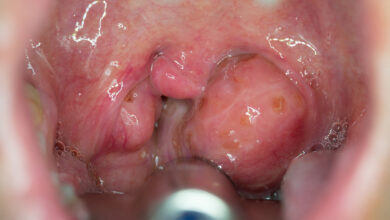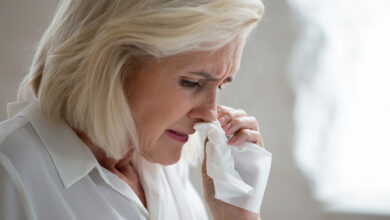HAND, FOOT, AND MOUTH DISEASE: It’s Ruined a More Than One Vacation.

Just before a friend and his family were preparing to leave for a cruise vacation, his daughter came down with a case of hand-foot-and-mouth disease. Her rash cleared up and the cruise looked like a certainty when he suddenly came down with it himself. He thought about the timing of the rash and illness compared to when they were to leave for the cruise and decided his plans were doomed, and he would need to reschedule the cruise.
Such is the disruptive affect a seemingly benign viral illness can have on families and their travel plans. Hand-Foot-and-Mouth Disease, henceforth known as HFMD, is a highly contagious infectious disease caused by a number of viruses. Two-hundred thousand cases are diagnosed annually, with infants and children under the age of five years the most common sufferers. Its characteristic blister-like lesions on the palms of the hands, soles of the feet, and lining of the mouth give this viral disorder its aptly-descriptive name. What else would you call a disease that affects the hands, feet, and mouth?
A number of viruses, most commonly in the Coxsackie virus family, are responsible for the disease, so potentially it can occur more than once. The illness spreads quickly from person-to-person when an ill patient sheds and spreads the virus in his saliva or nasal secretions, in respiratory droplets, in stool, or from fluid in the blisters, to another unsuspecting individual. Close contact with a patient sick with HFMD will almost certainly lead to illness in a susceptible person. The duration of contagion is much longer than for most other viral illnesses so despite a patient seemingly feeling well, HFMD remains transmissible for weeks after the acute illness is over. Unsuspecting children and adults are exposed to others who carry the virus and unknowingly spread it to others.
The diagnosis of HFMD is made by recognition of the classic rash (described below) coupled with fever, sore throat, loss of appetite, lethargy, and a feeling of being ill (malaise). The rash is found on the palms of the hands, soles of the feet, and the lining of the mouth, or any combination thereof. It may occur on the tongue, lips, gums, or throat, and has red, pinpoint lesions that sometimes have yellow blisters on the surface. They are very tender at times.
Hand and foot lesions resemble one another. They are tender, yellow blisters with surrounding redness. The incubation period (the time from exposure to the virus to fever and rash) is 3-6 days, during which time contagion begins. After an outbreak of clinical HFMD, the patient remains contagious for several weeks after the rash subsides. The exact duration is uncertain, but children should refrain from exposure to healthy individuals for at least a week. My friend had to cancel his cruise plans because he would have still been contagious during the entire time of the trip.
Childcare centers are the primary location of transmission of HFMD from sick to healthy individuals by person-to-person contact. Young children have not developed immunity to the causative virus, and since there is no vaccine for HFMD, they are susceptible to transmission from contact with saliva, feces, or the HFMD blisters themselves. Careful hand washing with soap and water for 20 seconds by parents and caregivers after changing diapers or other similar activities is an important preventive measure. Learning good hygiene techniques teaches patients how not to transmit disease from one person to another. Disinfecting high-use areas and surfaces with soap and water and/or disinfectant solutions helps prevent disease transmission. A last resort measure is isolation of infected children from those who are well.
My friend did not go on the cruise because his episode of HFMD was not completely resolved when it came time to leave, even though he was clinically well and free of skin lesions. He was considered to still be contagious. The last thing a cruise line wants is an outbreak of HFMD among passengers on one of its cruiseships. For them that’s a disaster, and it’s not fun for people, either.
HFMD has no specific treatment that will shorten the duration of the outbreak, and it is usually a minor illness causing only a few days of fever, rash, and other symptoms. It simply has to run its course, and treatment of the symptoms is the only thing available to patients. Acetaminophen and ibuprofen help fever, headaches, and muscle aches, while gargling eases mouth sores, fluids prevent dehydration, and rest and limited exposure to others are helpful to those diagnosed with HFMD. On rare occasions, HFMD patients will worsen and develop viral meningitis or encephalitis. These complications require supportive care targeted to prevent worsening or other complications. The prognosis for complete recovery is very good. Residual effects are usually not a problem.
DR. G’s OPINION: Hand-Foot-and-Mouth Disease is a common, highly contagious disease among infants, children, teens, and young adults. It spreads rapidly because it is contagious for 2 or 3 days before the blister-like rash occurs and for a week or more after it clears. So one potentially transmits the virus to others before, during, and after the acute illness. You’re exposed to the virus by someone who doesn’t know they have the illness as well as after they think they are well. That’s why it’s so common. The rash is easily recognizable, and symptoms are usually mild and self-limited (go away on their own).
But as I mentioned, HFMD has caused a lot of missed days at work or school and the postponement or cancellation of many vacations. Its degree of transmissibility is significant, and good hygiene procedures are important for the prevention of transmission and for keeping large numbers of cases from developing.
References: mayoclinic.org/diseases-conditions/Hand-Foot-and-mouth–disease.
Sun BJ, Chen HJ, Chen Y, An XD, Zhou BS. “The risk factors of acquiring severe hand, foot, and mouth disease: a Meta-Analysis,” Can J Infect Dis Med Microbiol. 2018 Jun 26;2018:2751457.
Guo N, Ma H, Deng J, Ma Y, Huang L, Guo R, Zhang L. Medicine (Baltimore). 2018 Dec;97(51):e13144.
Authors Unknown. “Risk Factors for Hand, Foot, and Mouth Disease” Can J Infect Dis and Med Micr addt’nl ifo missing.




